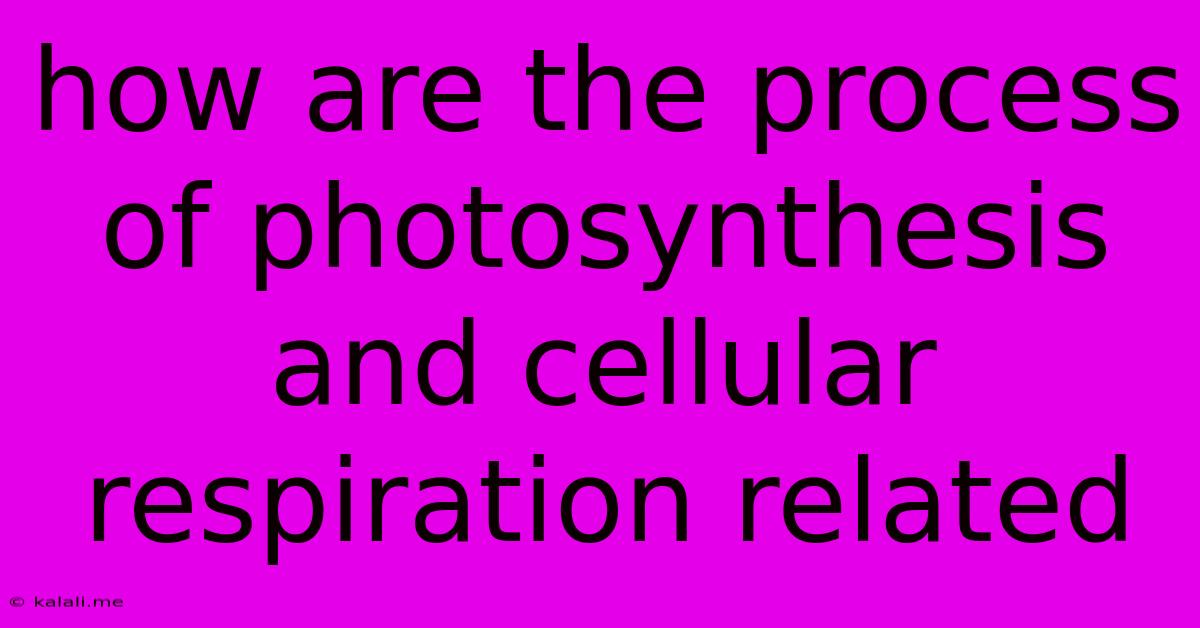How Are The Process Of Photosynthesis And Cellular Respiration Related
Kalali
May 09, 2025 · 3 min read

Table of Contents
How Photosynthesis and Cellular Respiration Are Intertwined: A Biological Dance
Photosynthesis and cellular respiration are two fundamental processes in biology, often described as opposites. This article will delve into the intricate relationship between these processes, explaining how they are intrinsically linked and crucial for the survival of most life on Earth. Understanding their interconnectedness reveals a fascinating example of biological balance and the cyclical flow of energy within ecosystems.
Photosynthesis: Capturing Sunlight's Energy
Photosynthesis is the process by which green plants, algae, and some bacteria convert light energy into chemical energy in the form of glucose (a sugar). This process occurs within chloroplasts, specialized organelles containing chlorophyll, the pigment that absorbs sunlight. The overall reaction can be summarized as:
6CO₂ + 6H₂O + Light Energy → C₆H₁₂O₆ + 6O₂
This equation shows that carbon dioxide (CO₂) and water (H₂O) are used in the presence of light energy to produce glucose (C₆H₁₂O₆) and oxygen (O₂). Glucose acts as stored energy, powering the plant's growth and various metabolic activities. Oxygen is a byproduct, crucial for the respiration of many organisms.
Key Steps in Photosynthesis:
- Light-dependent reactions: These reactions convert light energy into chemical energy in the form of ATP (adenosine triphosphate) and NADPH (nicotinamide adenine dinucleotide phosphate). Water is split in this process, releasing oxygen.
- Light-independent reactions (Calvin cycle): ATP and NADPH produced in the light-dependent reactions are used to convert CO₂ into glucose. This process doesn't directly require light but relies on the products of the light-dependent reactions.
Cellular Respiration: Releasing Stored Energy
Cellular respiration is the process by which organisms break down glucose to release the stored energy. This energy is then used to power various cellular processes, including growth, movement, and reproduction. This occurs in the mitochondria, the "powerhouses" of the cell. The simplified equation is the reverse of photosynthesis:
C₆H₁₂O₆ + 6O₂ → 6CO₂ + 6H₂O + ATP
This shows that glucose and oxygen are used to produce carbon dioxide, water, and importantly, ATP – the energy currency of the cell. ATP provides the energy needed for cellular work.
Stages of Cellular Respiration:
- Glycolysis: The initial breakdown of glucose into pyruvate, a smaller molecule. This occurs in the cytoplasm.
- Krebs cycle (Citric Acid Cycle): Pyruvate is further broken down, releasing carbon dioxide and generating ATP and electron carriers (NADH and FADH₂). This takes place in the mitochondria.
- Electron transport chain: Electrons from NADH and FADH₂ are passed along a chain of protein complexes, releasing energy used to generate a large amount of ATP. Oxygen acts as the final electron acceptor, forming water.
The Interdependence: A Cycle of Life
The relationship between photosynthesis and cellular respiration is cyclical and symbiotic. Photosynthesis produces the glucose and oxygen that are used in cellular respiration. Cellular respiration, in turn, produces the carbon dioxide and water used in photosynthesis. This continuous exchange of materials and energy sustains the majority of life on Earth.
- Plants and autotrophs: They perform photosynthesis, creating their own food and releasing oxygen as a byproduct, essential for the respiration of heterotrophs (animals, fungi, etc.).
- Animals and heterotrophs: They consume plants (or other animals that consume plants) to obtain glucose, utilizing cellular respiration to extract energy from this glucose and releasing carbon dioxide as a byproduct, which is then used by plants in photosynthesis.
This elegant cycle showcases the interconnectedness of life and the efficient flow of energy within ecosystems. The products of one process are the reactants of the other, creating a continuous loop that sustains the biosphere. Disrupting this balance, for example through deforestation or pollution, can have significant consequences for the entire ecosystem. Understanding this relationship is crucial for appreciating the delicate balance of nature and the importance of preserving biodiversity.
Latest Posts
Latest Posts
-
What Is 75 Percent Of 16
May 09, 2025
-
What Is 60 Of 75 Of 60
May 09, 2025
-
What Is 12 7 Mm In Inches
May 09, 2025
-
29 Cm Is Equal To How Many Inches
May 09, 2025
-
Cuanto Es 88 Grados Fahrenheit En Centigrados
May 09, 2025
Related Post
Thank you for visiting our website which covers about How Are The Process Of Photosynthesis And Cellular Respiration Related . We hope the information provided has been useful to you. Feel free to contact us if you have any questions or need further assistance. See you next time and don't miss to bookmark.